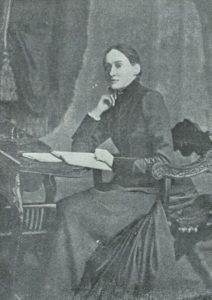Teaching Charlotte Riddell’s Irish Gothic Fiction
Dr Dara Downey
 About a year ago, I found myself (in a situation that will be familiar to many scholars) teaching far outside my comfort zone. I am first and foremost an Americanist, and, rightly or wrongly, have spent much of my career carefully avoiding what often seems to me to be the ideologically and emotionally fraught terrain of Irish literature in general, and of the Anglo-Irish Revival in particular. This time around, however, it was unavoidable, though thankfully, the system then in place where I was working meant that the second-year seminars I was teaching needed only a very broad association with the accompanying lectures.
About a year ago, I found myself (in a situation that will be familiar to many scholars) teaching far outside my comfort zone. I am first and foremost an Americanist, and, rightly or wrongly, have spent much of my career carefully avoiding what often seems to me to be the ideologically and emotionally fraught terrain of Irish literature in general, and of the Anglo-Irish Revival in particular. This time around, however, it was unavoidable, though thankfully, the system then in place where I was working meant that the second-year seminars I was teaching needed only a very broad association with the accompanying lectures.
In addition to focusing on American literature, I am also a gothicist, and with Halloween looming, this struck me as an ideal opportunity to gain a better understanding of the gothic fiction of my native land. Some of the choices for a course on fin-de-siècle Irish gothic were reasonably obvious – Oscar Wilde, J. Sheridan Le Fanu, Bram Stoker (though, worrying that the course might not seem Irish enough, I set The Snake’s Pass rather than Dracula, with rather mixed results), Elizabeth Bowen, and a few poems by William Allingham and W.B. Yeats (in an effort to integrate the darker aspects of the folklore revival – in other words, I wanted some scary fairies). My students responded well to many of the texts, and even to my efforts to steer them towards issues relating to national and transnational identities, mythologies, and conflicts, though they found the Stoker interminably dull, and I can’t say I blamed them. While the class politics and religious dynamics in The Snake’s Pass are interesting in places, the conjunction of long passages on land surveying, cringe-inducing stage Irishness, and sickly sentimentality makes Stoker’s early novel rather hard going.
Far more enjoyable and successful, both as a pedagogical experience and as part of my own ongoing research into neglected women writers, was the week we spent on Charlotte Riddell’s ghost stories. Again, feeling a bit self-conscious about my lack of expertise on Irish writing, I made sure that the stories we focused on (“Hertford O’Donnell’s Warning” (1874), “The Uninhabited House” (1875), and “The Last of Squire Ennismore” (1888)) were as explicitly related to the overall module concerns as possible. Nonetheless, Riddell’s own biography seemed to be a source of concern to my students, who I suspect were as anxious as I was to ensure that these stories were “really” Irish. Riddell was born Charlotte Cowen in Carrigfergus in 1832; the family were quite well off, until her father suffered a breakdown of some kind and left them penniless during his lifetime, and even worse off after his death. Charlotte and her mother moved to London, where her mother died shortly after, and where Charlotte married Joseph Hadley Riddell, an unsuccessful businessman. Like many women authors in the nineteenth century (and indeed since), Charlotte Riddell effectively kept the family afloat with her writing during the mid-1800s, and indeed her work proved reasonably popular. On her husband’s death in 1880, however, Riddell was again left penniless, a situation exacerbated by the fact that her writing failed to keep pace with rapidly changing tastes and manners.
Her life was therefore characterised by two major themes – the need to provide for her  family through writing when the men in her life proved unable to do so, and the loss of close family members. The combination of sharply felt grief and the need to make money in a hurry is perhaps one reason for the fact that so many women writers in the second half of the nineteenth century turned to a genre that has enduring commercial appeal and that often deals closely and explicitly with loss and mourning – the ghost story. Mary Elizabeth Braddon and Margaret Oliphant both turned to uncanny tales as a means of financial support, as did many of Riddell’s contemporaries in America, including Louisa May Alcott, Elia W. Peattie, and Charlotte Perkins Gilman, and later, Shirley Jackson. At the same time, these writers also employ the genre as a vehicle for expressing a range of emotions in the face of death, decay, and the unpredictability of life, as well as for critiquing the status quo and its deleterious effects on women’s lives.
family through writing when the men in her life proved unable to do so, and the loss of close family members. The combination of sharply felt grief and the need to make money in a hurry is perhaps one reason for the fact that so many women writers in the second half of the nineteenth century turned to a genre that has enduring commercial appeal and that often deals closely and explicitly with loss and mourning – the ghost story. Mary Elizabeth Braddon and Margaret Oliphant both turned to uncanny tales as a means of financial support, as did many of Riddell’s contemporaries in America, including Louisa May Alcott, Elia W. Peattie, and Charlotte Perkins Gilman, and later, Shirley Jackson. At the same time, these writers also employ the genre as a vehicle for expressing a range of emotions in the face of death, decay, and the unpredictability of life, as well as for critiquing the status quo and its deleterious effects on women’s lives.
Interestingly, however, despite Riddell’s place within this tradition of women’s writing acting as a means of supporting less successful men who, according to social dictates, should be the main earners in the family, the stories I chose to focus on for class by Riddell all in fact filtered through male viewpoints – though this does not mean that her stories aren’t critical of hegemonic masculinity. This is particularly evident in “Hertford O’Donnell’s Warning,” which is, in many respects, a tale of male loss and grief. The eponymous protagonist is an Irishman who has been living in London, where he works as a surgeon. A series of strange noises and disturbing dreams drive him to the hospital in the middle of the night, where we learn that he had a lover in Ireland who he was forced to abandon, while she was pregnant, as the result of a family feud. The wail of the banshee has, somehow, reunited him with his son just as the latter is dying from a terrible fall, but rather than finding some way to comfort (or apologies to!) the mother, who is clearly poor and destitute, and now also bereaved, O’Donnell leaves her once again and marries an heiress to whom he confesses everything, and who seems to heal his troubled soul. This denouement both troubles and clarifies the earlier sections of the story, which dwell on the Irishman’s attractive appearance, solitary manner, dissolute ways, and universal popularity at the hospital. While the narration is succinct and merely reports, rather than commenting on, these somewhat incompatible descriptions, the train of events would suggest that Riddell’s tale carefully balances a desire to arouse readerly sympathy for this man and his regrets with a strident critique of the behaviour of privileged men in London, and its repercussions for Irish womanhood.
Despite my best efforts, my students were reluctant to be drawn into a discussion on toxic masculinity, and instead latched on to issues around hybrid, emigrant Irish identities, and that was that. Even less successful was our discussion of “The Last of Squire Ennismore,” which began and ended with brief assertions from the classes about Irish Catholic superstition and bad landlords. The economic aspects, however, seemed to grip their imaginations far more firmly when we came to the somewhat longer piece “The Uninhabited House,” my personal favourite of the three (perhaps I was unconsciously influencing them here). They eagerly picked up on the concerns with money and legal matters throughout the stories, and I tried my best to steer them towards thinking about how these are worked into gothic plots in the stories, and particularly in “The Uninhabited House.” The novella revolves around a court case relating to a house in London that its owners – an elderly, unmarried, comically haughty Irish woman with a strained English accent, and her beautiful young niece – claim is haunted, and that gives the lawyers who manage it no end of headaches. This, at any rate, seems to be the reason why tenants repeatedly run out of the place, leaving the two women penniless. A young clerk, one of the few “nice guys” in these stories, sets out to discover the truth of what’s going on in the place, and ultimately, dark deeds are brought to light.
For my classes, this was what they had been after – a reasonably clear allegory for the relationship between Britain and Ireland at the end of the nineteenth century. Ireland, my students asserted confidently, was the uninhabited house, an awkward, troublesome, slightly embarrassing asset, riddled with the ghosts of past violence and neglect, something the English didn’t quite know what to do with. It also helped that, like Wilde’s “The Canterville Ghost,” “The Uninhabited House” provided them with a feisty young heroine who knows her own mind, and a satisfying marriage plot to round things off. Of course, there is far more to the text than this, but for one fifty-minute class, it worked beautifully, and everyone was happy.
If I had the opportunity to do this again, I would cover the short stories one week and the novella the next, and maybe even organise an entire course on women writers with connections to Ireland from the middle of the nineteenth century to the middle of the twentieth – Braddon as well as Daphne du Maurier and Dorothy Macardle would seem to be ideal for something along these lines, and I’m sure there are many more I haven’t come across yet. What I really learnt from the experience, though, is that, while there may be some resistance to new things, students can respond well to moving beyond the Wilde-Stoker-Yeats monopoly on Irish writing, and that the overtly “feminine” concerns often dealt with by women writers – from marriage and family matters to abandonment, poverty, and grief – can be just as useful (if not more so) for helping students engage with Ireland’s troubled past and present.
If you would like to contribute to our blog please contact Dr Deirdre Flynn



